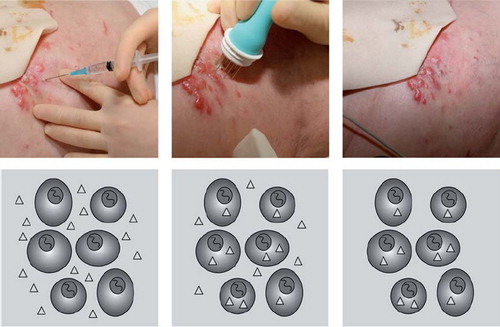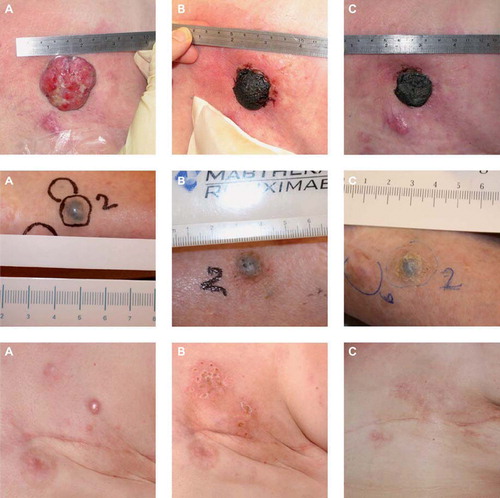Figures & data
Figure 1. The electroporation procedure: A. Electroporation occurs when an applied external field exceeds the capacity of the cell membrane. The formation of permeable areas happens in the frame of less than a second whereas resealing happens over minutes. As the resting transmembrane potential is negative on the inside respective to the outside, the first part of the membrane that will be permeabilised is the pole facing the positive electrode. The positive electrode should be imagined in the left of the picture and the negative electrode on the right. Pulses were delivered to a cell suspended in medium containing propidium iodide and after the pulses propidium iodide is trapped within the cells [Citation9]. B. The application of pulses to skin tumours must be preceded by local or general anaesthesia, in local anaesthesia the lidocain is injected around the metastasis. C. The cliniporator equipment allows monitoring of voltage and current during the pulse. D. A treatment situation is shown where a patient is receiving local injection of bleomycin followed by application of pulses under local anaesthesia. The application of pulses lasts only a few minutes in total.
![Figure 1. The electroporation procedure: A. Electroporation occurs when an applied external field exceeds the capacity of the cell membrane. The formation of permeable areas happens in the frame of less than a second whereas resealing happens over minutes. As the resting transmembrane potential is negative on the inside respective to the outside, the first part of the membrane that will be permeabilised is the pole facing the positive electrode. The positive electrode should be imagined in the left of the picture and the negative electrode on the right. Pulses were delivered to a cell suspended in medium containing propidium iodide and after the pulses propidium iodide is trapped within the cells [Citation9]. B. The application of pulses to skin tumours must be preceded by local or general anaesthesia, in local anaesthesia the lidocain is injected around the metastasis. C. The cliniporator equipment allows monitoring of voltage and current during the pulse. D. A treatment situation is shown where a patient is receiving local injection of bleomycin followed by application of pulses under local anaesthesia. The application of pulses lasts only a few minutes in total.](/cms/asset/731c2e24-dc91-42ab-971b-4d580c985083/ionc_a_573626_f0001_b.jpg)
Figure 2. Electrochemotherapy. In the right panel, bleomycin is injected at the tumour site, at a concentration of 1000 IU/ml (1 U/ml). In the middle panel the electric pulses are subsequently applied, cells are permeabilised and the drug enters. In the left panel the cells reseal after a few minutes and the extracellular drug is washed out while the internalised molecules remain trapped intracellularly.

Figure 3. Results. Top: ECT treatment of a 75-year-old woman with metastatic breast cancer. Previously the patient underwent surgery and received endocrine therapy, chemotherapy and radiotherapy. The patient was treated with one single treatment of ECT in local anaesthesia with intratumoural injection of bleomycin. A. before treatment, B. two weeks after treatment, C. four weeks after treatment. A crust formed and after four weeks showed signs of falling of. The patient was very satisfied with the treatment and had no side-effects. Middle: ECT treatment of an 82-year-old woman with malignant melanoma. The patient was diagnosed in 2007, since had local spread on the lower limb and metastasis to the lungs. The patient was not suited for temozolamide, immunotherapy or isolated limb perfusion. The patient was treated with ECT in general anaesthesia and intravenous injection of bleomycin. A. before treatment, B. 24 days after treatment and C. three months after treatment. After three months the metastasis is in partial response. Bottom: ECT treatment of a 38-year-old woman with metastatic breast cancer. Previously the patient underwent mastectomy, radiotherapy and chemotherapy. The patient was treated with one single treatment of ECT in general anaesthesia with i.v. injection of bleomycin. A. before treatment, B. 10 weeks after treatment, C. two years and two months after treatment with complete resolution despite ongoing systemic disease.

Table I. Patients’ characteristics at baseline.
Table II. Treatment data and response.
Table III. Choice of anaesthesia according to location of metastases and size.